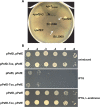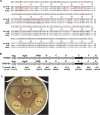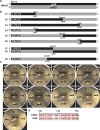Subtle variation within conserved effector operon gene products contributes to T6SS-mediated killing and immunity
- PMID: 29155899
- PMCID: PMC5714391
- DOI: 10.1371/journal.ppat.1006729
Subtle variation within conserved effector operon gene products contributes to T6SS-mediated killing and immunity
Abstract
Type VI secretion systems (T6SS) function to deliver lethal payloads into target cells. Many studies have shown that protection against a single, lethal T6SS effector protein requires a cognate antidote immunity protein, both of which are often encoded together in a two-gene operon. The T6SS and an effector-immunity pair is sufficient for both killing and immunity. HereIn this paper we describe a T6SS effector operon that differs from conventional effector-immunity pairs in that eight genes are necessary for lethal effector function, yet can be countered by a single immunity protein. In this study, we investigated the role that the PefE T6SS immunity protein plays in recognition between two strains harboring nearly identical effector operons. Interestingly, despite containing seven of eight identical effector proteins, the less conserved immunity proteins only provided protection against their native effectors, suggesting that specificity and recognition could be dependent on variation within an immunity protein and one effector gene product. The variable effector gene product, PefD, is encoded upstream from pefE, and displays toxic activity that can be countered by PefE independent of T6SS-activity. Interestingly, while the entire pef operon was necessary to exert toxic activity via the T6SS in P. mirabilis, production of PefD and PefE alone was unable to exert this effector activity. Chimeric PefE proteins constructed from two P. mirabilis strains were used to localize immunity function to three amino acids. A promiscuous immunity protein was created using site-directed mutagenesis to change these residues from one variant to another. These findings support the notion that subtle differences between conserved effectors are sufficient for T6SS-mediated kin discrimination and that PefD requires additional factors to function as a T6SS-dependent effector.
Conflict of interest statement
The authors have declared that no competing interests exist.
Figures







References
-
- Pukatzki S, Ma AT, Sturtevant D, Krastins B, Sarracino D, Nelson WC, et al. Identification of a conserved bacterial protein secretion system in Vibrio cholerae using the Dictyostelium host model system. P Natl Acad Sci USA. 2006;103(5):1528–33. doi: 10.1073/pnas.0510322103 - DOI - PMC - PubMed
-
- Mougous JD, Cuff ME, Raunser S, Shen A, Zhou M, Gifford CA, et al. A virulence locus of Pseudomonas aeruginosa encodes a protein secretion apparatus. Science. 2006;312(5779):1526–30. doi: 10.1126/science.1128393 - DOI - PMC - PubMed
-
- Pukatzki S, Ma AT, Revel AT, Sturtevant D, Mekalanos JJ. Type VI secretion system translocates a phage tail spike-like protein into target cells where it cross-links actin. P Natl Acad Sci USA. 2007;104(39):15508–13. Epub 2007/09/18. 0706532104 [pii] doi: 10.1073/pnas.0706532104 ; PubMed Central PMCID: PMC2000545. - DOI - PMC - PubMed
-
- Ma AT, Mekalanos JJ. In vivo actin cross-linking induced by Vibrio cholerae type VI secretion system is associated with intestinal inflammation. P Natl Acad Sci USA. 2010;107(9):4365–70. doi: 10.1073/pnas.0915156107 - DOI - PMC - PubMed
-
- Hood RD, Singh P, Hsu F, Guvener T, Carl MA, Trinidad RR, et al. A type VI secretion system of Pseudomonas aeruginosa targets a toxin to bacteria. Cell Host Microbe. 2010;7(1):25–37. Epub 2010/02/02. S1931-3128(09)00417-X [pii] doi: 10.1016/j.chom.2009.12.007 ; PubMed Central PMCID: PMC2831478. - DOI - PMC - PubMed
MeSH terms
Substances
Grants and funding
LinkOut - more resources
Full Text Sources
Other Literature Sources

